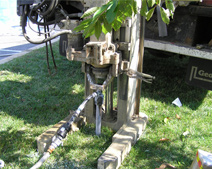Based on site conditions, a variety of oxidation and bioremediation technologies are available to reduce volatile organic compound (VOC) concentrations in soil and groundwater. Staff at ReSolution Partners will evaluate best-fit technologies based on site goals and schedules. Site-specific technologies can also be developed for sites with both heavy metals and VOC contamination.
 Chemical oxidation of organic compounds is a well established technology used in industrial processes and wastewater treatment. Chemical oxidation can be applied in an ex situ manner (e.g., piles of excavated soils). However, in the last 15 years, the application of in situ chemical oxidation (ISCO) to the remediation of soil and groundwater has grown from the use of hydrogen peroxide in the destruction of petroleum products to a suite of oxidizing agents applicable to a broad range of organic contaminants.
Chemical oxidation of organic compounds is a well established technology used in industrial processes and wastewater treatment. Chemical oxidation can be applied in an ex situ manner (e.g., piles of excavated soils). However, in the last 15 years, the application of in situ chemical oxidation (ISCO) to the remediation of soil and groundwater has grown from the use of hydrogen peroxide in the destruction of petroleum products to a suite of oxidizing agents applicable to a broad range of organic contaminants.
Typical oxidizers include peroxide, permanganate, and persulfate. Chemical oxidation is typically most cost-effective when applied to contaminant sources. Often, natural attenuation processes are then capable of mitigating residual concentrations in source areas and in downgradient plumes.
Enhanced bioremediation products use indigenous microorganisms that use chlorinated ethenes such as tetrachloroethene (PCE), trichloroethene (TCE), dichloroethenes (DCEs), and chloroethene (CE) or vinyl chloride (VC) for respiration under strongly anaerobic conditions. These naturally occurring organisms have been found a many sites where conditions are suitable for the growth of the organisms. Our approaches introduce reagents to establish or enhance, and maintain the strongly anaerobic conditions that are supportive of the biodegrading organisms.
During the reductive dechlorination process bacteria provides electrons to organisms and results in the sequential removal of chloride ions from the chlorinated ethenes, such that PCE degrades to TCE which in turn degrades to DCE, and ultimately to CE. The CE is typically more readily degraded in the aerobic environments that are commonly found downgradient of the anaerobic zones where reductive dechlorination takes place.
Example Approaches
- Source area: Application of oxidizers or biodegradation enhancers to source areas through direct push injection technologies or wells.
- Biologically active zones: Application of biodegradation enhancers in biologically active zones within and downgradient of dissolved organic compound plumes.
- Stockpiles: Application of oxidizers to excavated stockpiles of soil and waste followed by off-site management or on-site beneficial reuse.
- Natural attenuation coupled with engineered remedies for the management of residual concentrations within or downgradient of source areas.
Example Sites
- Degreasing operations
- Dry cleaning facilities
- Chemical distribution facilities



